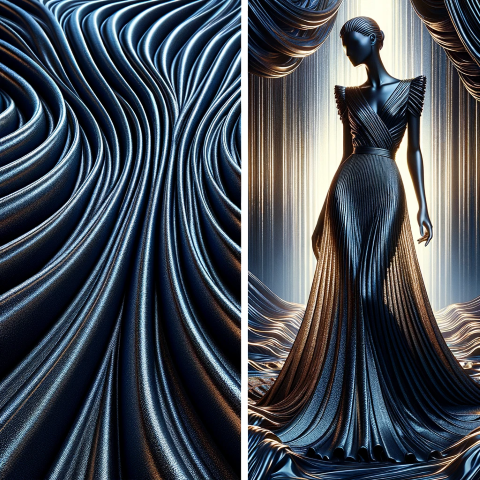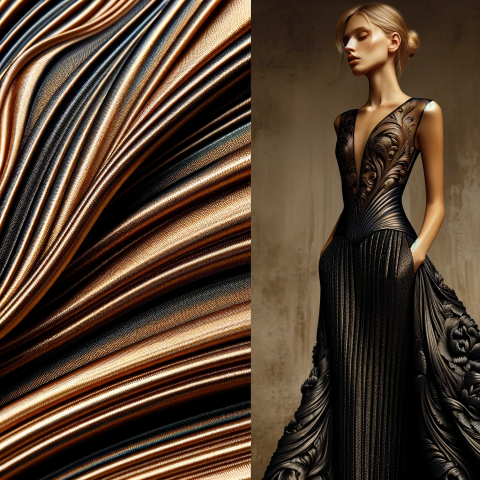Last Updated on: 10-Jun-2024 (1 month, 17 days ago)
Share on Facebook • Share on Twitter
Faille has a slightly lustrous appearance, but not as much as satin or silk. The texture and stiffness of the fabric make it ideal for creating structured garments such as evening gowns, jackets, and skirts. It is also used in home decor items such as draperies and upholstery.
One of the advantages of faille is its durability. The ribbed texture of the fabric makes it resistant to wrinkles and creases, which makes it a popular choice for travel or outdoor wear. Faille can also withstand repeated washings without losing its shape or texture.
Faille comes in a variety of colors and patterns. Solid-colored faille is commonly used for formal or evening wear, while patterned faille is used for a variety of purposes, including home decor and apparel. Faille can be printed or embroidered, which adds to its versatility.
Faille can be cared for in a variety of ways, depending on the fiber it is made from. Silk faille should be dry cleaned or hand washed with a gentle detergent and air dried. Cotton, rayon, or polyester faille can typically be machine washed and dried on a low heat setting.
In conclusion, faille is a type of woven fabric that is characterized by a slightly ribbed or corded texture. It is traditionally made from silk, but can also be made from other fibers such as cotton, rayon, or polyester. The ribbed texture of the fabric makes it ideal for creating structured garments such as evening gowns and jackets, as well as home decor items such as draperies and upholstery. Faille is durable, versatile, and comes in a variety of colors and patterns. It can be cared for in a variety of ways, depending on the fiber it is made from. Faille is a popular choice for fashion and home decor due to its unique texture and durability.
A glossy, soft, finely-ribbed, silk-like woven fabric made from cotton, silk, or manufactured fibers, especially rayon. It has a crosswise rib weave and the soft material drapes well. It is finer than grosgrain and with flatter ribs. It is difficult to launder but will give good wear if handled properly. Has a lustrous finish.
�A plain weave fabric characterized by a narrow, crosswise rib which is usually the result of a fine warp yarn crossed with a heavier weft yarn. Most commonly made with filament yarns but can be from a variety of fibers and weights. It usually has a soft hand and a light luster with good body and drape.
�A flat. ribbed fabric woven with fine yarns in the warp, with heavier yarns in the filling.using a plain weave. The ribbed effect is flatter than gross grain and smaller than a repp. The fabric is the base cloth used far Moire.
�A soft, slightly glossy woven fabric made of silk, rayon, cotton, wool, or manufactured fibers or combinations of these fibers and having a light, flat crossgrain rim or cord made by using heavier yarns in the filling than in the warp.
Fabric with a flat ribbed weave. This fabric drapes and wears well, hence is ideal for slacks and dress wear. Faille was originally made of silk but for quality menswear is now most commonly made of fine woolens.
�Faille is a ribbed fabric finish with structure and body. This finish is also seen in bridesmaids styles today. Most faille finishes are woven from silk, cotton, rayon or polyester fabrics.
Some more terms:
Apron dress
An apron dress is a versatile garment that combines the functionality of an apron with the style and design elements of a dress. It is a synonym for neckties and is widely used in the textile...
Read about Apron dressTenacity Defined: How Fiber Strength Determines Fabric Durability
The property of fibers that measures strength. This is determined by the force required to rupture of break the fiber. Typically, this is measure is grams per denier, or g/d. Tensile strength measres...
Read about TenacityFixing
Fixing is the term described for the various ways of getting dyes stuck onto or into fibres. Fixing is part of the dyeing process and differs from after-fixing which is generally used to describe a...
Read about FixingSolid wood
In textile manufacturing, "solid wood" refers to the use of genuine, natural wood as a raw material in the production of textiles. Solid wood textiles are characterized by their unique texture,...
Read about Solid woodFiber reactive dyes
Fiber reactive dyes are dyes used to color cellulosic and protein fibers such as cotton, rayon and soy. The dyestuff bonds to the fibers through a chemical reaction and does not require the use of...
Read about Fiber reactive dyesAtlas
In textiles, an atlas is a type of fabric that is characterized by its lustrous, shiny appearance and its tightly woven construction. It is typically made from a combination of silk and cotton or...
Read about AtlasSocks
A sock is a baglike covering for the foot and/or lower leg, which is designed to ease chafing between the foot to keep the feet warm and absorb sweat from the feet. Sock lengths vary, from covering...
Read about SocksButcher's Linen
A plain-weave, stiff fabric with thick-and-thin yarns in both the warp and the filling. The fabric was originally made of linen but is now duplicated in 100% polyester or a variety of blends such as...
Read about Butcher's LinenAdd a definition
- The term you want to define
- Its definition in 500 words or less
- Attach an image if necessary.
- Optionally, tell us about yourself in 200 words or less!
Companies for Faille:
- Company name
- Company address
- Attach a logo, if necessary.
- Optionally, tell us about yourself in 200 words or less!

 Fashion designer Zac Posen's first fashion show was held in his parents' living room.
Fashion designer Zac Posen's first fashion show was held in his parents' living room.

